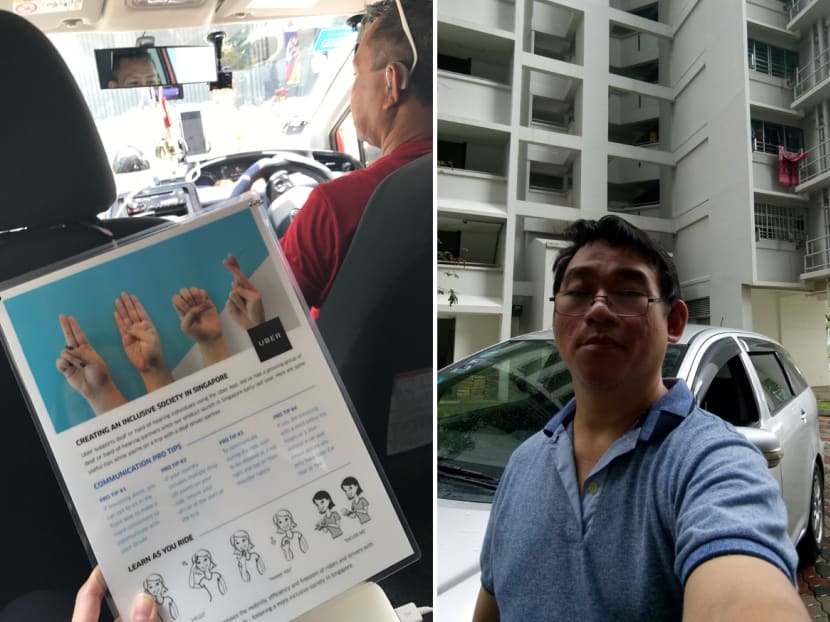Uber sees spike in drivers who are hearing-impaired, partners SADeaf in education outreach
SINGAPORE — The driver was hard of hearing, and the passenger was blind. Last month, the unlikely duo found themselves together on an Uber ride from Holland Village to Geylang, and technology proved itself to be an enabler in the chance encounter.

(Left) A collateral in some cars of Uber drivers with hearing impairment. (Right) Mr James Teo, the driver who is hard-off-hearing, picked up a rider who is visually-impaired last month. Photo: Uber
SINGAPORE — The driver was hard of hearing, and the passenger was blind. Last month, the unlikely duo found themselves together on an Uber ride from Holland Village to Geylang, and technology proved itself to be an enabler in the chance encounter.
The driver in this instance is Mr James Teo Hang Keong, 52, one of about 200 Uber drivers here who are hearing-impaired. He has clocked more than 2,000 rides on Uber’s app since last October.
Using the ride-hailing app, Mr Teo is aided by an in-app feature that Uber launched last September to make it easier for drivers like him to pick up passengers.
On the road one day, he saw his mobile phone’s screen flash repeatedly, indicating that there was a ride request. When he reached the pick-up point, he saw a man with a white cane waiting.
The blind man tried to speak to him, and although Mr Teo could not hear him, he managed to ascertain that the man was indeed his rider by reading his lips.
The man was able to book the ride because Uber is compatible with VoiceOver iOS, Android TalkBack and wireless braille display.
When Mr Teo arrived at the passenger’s destination after “a rather quiet ride”, the rider signed “thank you” with his hands — to the surprise and delight of Mr Teo who, in turn, held the man’s hands in appreciation.
Uber told of the meeting between the two men on Friday (Sept 15), while giving an update of its initiative to make the ride-hailing mobile application friendlier for deaf drivers.
UBER, AMBASSADOR FOR DEAF COMMUNITY
Mr Jonathan Wong, Uber Singapore’s head of operations, told TODAY that Uber is an “extremely data-driven company”, but “some of the things which are harder to quantify (with metrics or key performance indicators) often should make the top of the list”.
That is why it is becoming the ambassador for the Singapore Association for the Deaf (SADeaf), a voluntary welfare group that has been serving the deaf and hard-of-hearing community here.
This partnership was announced on Saturday (Sept 16) at an event celebrating next week’s International Week of the Deaf.
In a statement, Ms Sylvia Teng, executive director of SADeaf, said: “We look forward to working closely with Uber for public education in deaf culture and sign language, to enable the public to communicate with the deaf and hard-of-hearing drivers when they come across them. We are hoping that our partnership will lead to more job opportunities for the deaf and hard-of-hearing community.”
When asked why Uber chose to partner with the deaf and hard-of-hearing community, Mr Wong said: “I think they are a very good representation of tenacity, determination and willpower to make sure that their situation of them being deaf or hard-of-hearing has no impact on their ability to live a normal and independent lifestyle.”
Having seen the number of drivers who are hearing-impaired jump from 20 to more than 200 in the past year, Mr Wong said that Uber would be working “more closely with the organisation to help find solutions for this community”, including developing more co-branded marketing materials to educate riders on how to communicate with deaf drivers.
SIGN-LANGUAGE TIPS
One of such materials produced has been placed in the cars of some of these drivers. It contains tips for passengers, such as how to communicate with the driver (wait until the car stops at a red light and tap on the driver’s shoulder lightly), as well as simple sign language to say “hello”, “thank you” and “excuse me”.
This came about after gathering the feedback from three focus groups with its drivers who are hearing-impaired and who said that there is a general lack of awareness for Singapore’s community of deaf drivers.
As part of this ambassadorship for SADeaf, Uber Singapore’s staff members will be going through awareness programmes conducted by the association to better communicate with their deaf driver-partners.
In addition, Uber will gift S$22,000 worth of rides to SADeaf — S$12,000 to go to interpreters from the association to cover their transport costs for assignments, and S$10,000 to be disbursed by SADeaf to deaf passengers who are new to using Uber.
It is quite rare to see hearing-impaired taxi drivers in Singapore, because a vocational licence is required.
Since a new rule kicked in on July 1, making it a requirement for all private-hire drivers to get their private car driver’s vocational licence (PDVL), all drivers who are hearing-impaired were able to get their PDVL, Mr Wong said.
Uber’s hiring of such drivers have stayed the same, going by the Land Transport Authority’s standards, where the drivers cannot be 100-per-cent deaf and must be able to hear at least 50 decibels, he added.








